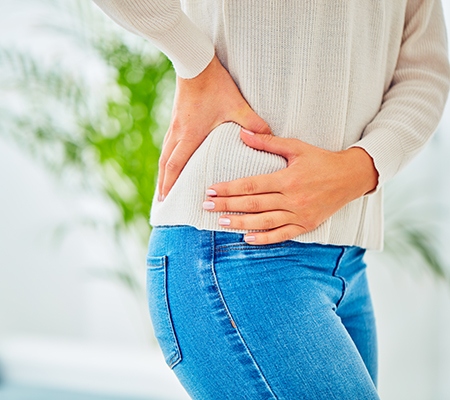
Sharp and intense pain across your hip after you have been on your feet all day may be more than just fatigue. It could be hip bursitis or inflammation of the bursa, the small, jelly-like sac between your bones and soft tissues. The bursa acts like a cushion to reduce friction.
Dr. Chad Giles, Marshfield Clinic Health System sports medicine physician, says that isolated hip bursitis is rare. “Typically hip bursitis occurs in combination with a gluteal tendon problem,” he said.
This is called greater trochanteric pain syndrome and is often the result of scar-like tissue in the tendon known as gluteal tendinopathy. Other causes include inflammation (tendinitis), tendon strains and even tendon tears.
Causes of hip bursitis
The ache and pain intensifies with prolonged pressure on the side of the hip or with activity. You may have difficulty sleeping at night due to discomfort from laying on the affected side. You also could experience pain after walking longer distances, ascending stairs or getting up from a seated position.
This hip pain can be from trauma or injury. “Just like cartilage within knees or joints, tendons can wear out over time or with overuse,” Giles said.
Because of this, it often affects people ages 40 to 60 years old. Women are more likely to develop hip bursitis, partially due to body structure. Others at risk include people with higher body mass index and individuals with knee arthritis or lower back pain. Athletes also can have hip issues if they change running form or ramp up their running program too quickly.
Overuse or tightness in the leg muscles and glutes are another common cause. “We often see runners and patients with tight IT (iliotibial) bands with the condition,” Giles said.
Heal and reduce further aggravation
Talk with your physician about your symptoms. To pinpoint the cause, your physician completes a physical exam and may take X-rays. If they suspect more serious tendon issues, they also look at an ultrasound or MRI.
“We talk about symptoms and their underlying causes so we can develop the most effective individualized treatment plan,” Giles said. “We want to treat the underlying issue in addition to managing the pain.”
Pain from hip bursitis is treated with Tylenol, NSAIDs (nonsteroidal anti-inflammatory drugs), and ice and heat. Physical therapy or home exercises for gluteal strengthening are essential to treat the underlying gluteal tendon problem. Some daily changes you can make include laying on your opposite side with a pillow between your legs to relieve tension and help with discomfort during the night.
You can help prevent further issues by strengthening and stretching your hip, legs and back. You’ll also want to stretch and strengthen your glutes, quads and hamstrings. Stretching is most effective during the warm up or cool down phases of exercise.
Surgery when other treatments fail
Cortisone injections are used when severe pain interferes with sleep or effective physical therapy. However, too many cortisone injections can be harmful over time. When all other treatment options have failed, there are regenerative type tendon procedures or arthroscopic surgery to take out the bursa and lengthen the IT band.
Related Shine365 posts
Tips for tightness in your IT band






Leave a Reply